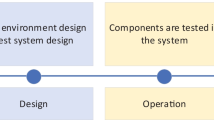Abstract
Digital twin technology is a key technology to realize cyber-physical system. Owing to the problems of low visual monitoring of the blade-rotor test rig and poor equipment monitoring capabilities, this paper proposes a framework based on the digital twin technology. The digital-twin based architecture and major function implementation have been carried out form five dimensions, i.e. Physical layer, Virtual layer, Data layer, Application layer and User layer. Three key technologies utilized to create the system including underlying equipment real-time communication, virtual space building and virtual reality interaction have been demonstrated in this paper. Based on RS-485 and other communication protocols, the data acquisition of the underlying devices have been successfully implemented, and then the real-time data reading has been achieved. Finally, the rationality of the system has been validated by taking the blade-rotor test rig as the application object, which provides a reference for the monitoring and evaluation of equipment involved in manufacturing and experiment.

















Similar content being viewed by others
References
Alexopoulos, K., Nikolakis, N., & Chryssolouris, G. (2020). Digital twin-driven supervised machine learning for the development of artificial intelligence applications in manufacturing. International Journal of Computer Integrated Manufacturing, 33(5), 429–439.
Brosinsky, C., Krebs, R., & Westermann, D. (2020). Embedded Digital Twins in future energy management systems: Paving the way for automated grid control. at-Automatisierungstechnik, 68(9), 750–764.
Chao, Z., Xuhui, Z., Kaixin, Z., et al. (2020). Digital twin driven remote automatic cutting control technology of roadheader. Industry and Mine Automation, 46(09), 15–20.
Cheng, Z., Kaiting, S., Jiang, L., et al. (2020). Workshop 3D visual monitoring system based on digital twin[J/OL].Computer Integrated Manufacturing Systems, pp. 1–18[2020–10–20].
Cong, L., Kun, W., Chi, C., et al. (2019). Development and research of hydraulic fracturing virtual simulation experiment platform. Education Teaching Forum, 47, 273–274.
Fei, T. A. O., & Qinglin, Q. I. (2019). Make more digital twins. Nature, 573(7775), 490–491.
Havard, V., Jeanne, B., Lacomblez, M., et al. (2019). Digital twin and virtual reality: a co-simulation environment for design and assessment of industrial workstations. Production and Manufacturing Research, 7(1), 472–489.
Jianguo, D. (2015). Unified multi-domain physical modeling and simulation of test device for large-scale sliding bearings. The Magazine on Equipment Machinery, 03, 1–9.
Jianguo, D., & Xin, X. (2015). Overview of present status of virtual experimental technique and its application. Journal of Shanghai Electric Technology, 8(03), 1–12.
Kai, D., Xudong, Z., Guanghui, Z., et al. (2019). Digital twin-based multi-dimensional and multi-scale modeling of smart manufacturing spaces. Computer Integrated Manufacturing Systems, 25(06), 1491–1504.
Linyan, L., Hongxiang, D., Huifen, W., et al. (2019). Construction and application of digital twin system for production process in workshop. Computer Integrated Manufacturing Systems, 25(06), 1536–1545.
Li, S., Cui, X., & Li, G. (2018). Modelling and demonstration of electromagnetically assisted stamping system using an interactive mapping method. International Journal of Mechanical Sciences, 144, 312–323.
Long, G., Chenguang, H., & Jian, T. (2019). research on single aircraft quality monitoring technology based on digital twin. Aerospace Power, 04, 65–69.
Lu, Y., Liu, C., Kevin, I., Wang, K., et al. (2020). Digital Twin-driven smart manufacturing: Connotation, reference model, applications and research issues. Robotics and Computer-Integrated Manufacturing, 61, 101837.
Pengfei, Y., Zhengming, C., Jing, T., et al. (2016). Virtual simulation system of cutter suction dredger based on unity 3D. Journal of Systems Simulation, 28(9), 2069–2075.
Peng, X., Weibin, C., Liangchuan, L. I. A. O., et al. (2019). Study on digital Workshop of Marine Pipe Processing based on digital twin. Ship Science and Technology, 41(15), 139–144.
Pérez, L., Rodríguez-Jiménez, S., Rodríguez, N., Usamentiaga, R., & Garcia, D. F. (2020). Digital twin and virtual reality based methodology for multi-robot manufacturing cell commissioning. Applied Sciences, 10(10), 3633.
Talkhestani, B. A., Jung, T., Lindemann, B., Sahlab, N., Jazdi, N., Schloegl, W., & Weyrich, M. (2019). An architecture of an intelligent digital twin in a cyber-physical production system. at-Automatisierungstechnik, 67(9), 762–782.
Tao, F., Liu, W., Zhang, M., et al. (2019). Five-dimension digital twin model and its ten applications. Computer Integrated Manufacturing Systems, 25(1), 1–18.
Uhlemann, T. H. J., Schock, C., Lehmann, C., et al. (2017). The digital twin: Demonstrating the potential of real time data acquisition in production systems. Procedia Manufacturing, 9, 113–120.
Xiaolin, G. (2005). Real-time data acquisition technology of turbocharger test bed. Experimental Technology and Management, 06, 47–49.
Xuejun, C. (2012). Real-time acquisition and monitoring of the serial communication data under windows platform. Process Automation Instrumentation, 33(03), 66–69.
Xu, Z., Zhang, H., Wei, W., & Yang, Z. (2019). Virtual scene construction for seismic damage of building ceilings and furniture. Applied Sciences, 9(17), 3465.
Zhang, X., Liu, L., & Wan, X., et al. (2020). Assembly process planning and dynamic evaluation method based on digital twin. 17(3)
Zhao, H., Liu, J., Xiong, H., et al. (2019). 3D visualization real-time monitoring method for digital twin workshop. Computer Integrated Manufacturing Systems, 25(06), 1432–1443.
Zheng, L., Yang, C. R., & Cheng, L. Y. (2012). Application of web-based 3-D panoramic technology in the equipment visualization. Advanced Materials Research, 588, 1390–1393.
Zhiding, C., & Liping, M. (2020). Design of virtual real interaction system of hydraulic turbine based on digital twin technology. Water Resources and Power, 38(09), 167–170.
Author information
Authors and Affiliations
Corresponding author
Additional information
Publisher's Note
Springer Nature remains neutral with regard to jurisdictional claims in published maps and institutional affiliations.
Rights and permissions
About this article
Cite this article
Duan, JG., Ma, TY., Zhang, QL. et al. Design and application of digital twin system for the blade-rotor test rig. J Intell Manuf 34, 753–769 (2023). https://doi.org/10.1007/s10845-021-01824-w
Received:
Accepted:
Published:
Issue Date:
DOI: https://doi.org/10.1007/s10845-021-01824-w




